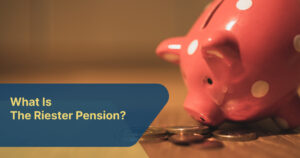
The Riester pension is a private old-age provision supported by state allowances and tax reductions. When you retire, all savings, allowances, and profits will be used to finance your pension.
In the savings phase of your Riester contract, you pay money yearly to have it paid out to you to either a lifelong pension or to buy your residential property (Wohn-Riester). The state supports this with an annual subsidy and tax advantages.
Employees Are Allowed To “Riester”
Simply put, every employee who pays into the statutory pension system can also pay into a Riester pension plan, including officials, judges, and soldiers. Additionally, for those looking for work, you can make private provisions. Housewives and househusbands can “Riester” if their spouses or life partners qualify.
The Premium Guarantee At Riester
Providers have to give you a premium guarantee. In the payment phase, they must guarantee to pay back your savings contributions and the government allowances.
However, this guarantee limits the Riester pension plan’s earning potential. Your money is invested in low-risk funds and bonds, to maintain the required reserves, reducing the investment returns. To possibly increase the returns, you can invest the free parts of your contributions in the stock market or into high-return ETFs.
These Fees Apply
With a Riester contract, there are closing and administration fees. The fees are included in your contributions and spread over the first five years of your contract. . Reducing the profits from the Riester pension plan over this time. Typically, sales, commission, and closing costs are around 3 to 6 percent of your posts. Another 1.5 percent of your contributions are due to administrating your deposits. Additional fees incur If you change insurers. You want to choose a Riester pension plan that is on the lower end with large variances in numbers.
What Riester Allowances Are There?
The state supports you in the savings phase with annual grants; the Riester allowances. In addition, you also benefit from tax advantages. For those beginning their career, there is even an extra bonus.
The Amount Of Your Riester Pension Allowance
The state supports you annually with grants of a certain amount, depending on whether you save as an individual or have children.
The basic allowance is 175 euros per year (since 2018). The child allowance is 185 euros is available for every child born by the end of 2007, increasing to 300 euros for children born after 2008.
You can apply for a child allowance for every child entitled to child benefits, with it being paid up until your child is 25.
Usually, the mother receives the child’s allowances. In the case of same-sex couples, the subsidies go to the partner, that gets the regular child benefit. It is possible to change this and use it for the father’s or other partner’s Riester pension plan, but this has to be requested and it depends on the mother’s permission.
For career starters up to 25, a one-time extra bonus of 200 euros exists.
You Pay That Into The Riester Pension Plan
Riester allowances are only available if you pay at least 4 percent of your gross annual income for the past year to be subsidized by the state of175 euros.
A minimum of 60 euros a year must be paid into your Riester pension plan. Those who qualify for a Riester pension plan do not necessarily have yearly income. With a requirement to invest 60 euros per year, they do not qualify for the annual gift of 175 euros and have to invest their own money. Importantly, there is also a limit to the amount you can contribute.
No matter your earnings, your contribution can never rise above 2,100 euros. 1,925 Euros if you deduct your personal allowance. It caps the potential of a Riester pension plan, reducing the burden for higher earners making it easier to integrate a Riester pension into their overall old age provisions.
The Tax Savings
In addition to the allowances, the Riester pension also brings tax advantages. You can claim your annual contributions and government allowances up to 2,100 euros as special expenses. To claim this, you must fill out Annex AV with the income tax return. The tax office will then check your tax savings (Günstigerprüfung). If accepted, this has an additional tax-reducing effect.
Generally, single people and high earners benefit from deducting special expenses because they pay in more of their own money but receive fewer allowances in return.
Who Benefits From A Riester?
Because of the state allowances, “Riester” is particularly suitable for families with several children and low earners. A new contract may be attractive for high earners because of the tax deductions, but alternatives like a Rürup-Rente or a BAV, with comparable benefits, may be preferred. . Since each situation differs, every case will have a different answer.
Useful For Families And Low Earners
A new contract is worthwhile if the state adds to your old-age provision. The reason for this is the continuous low-interest rates. . Even if you can only invest the minimum contribution of 60 euros per year, you are entitled to the Riester allowances in full. And the more children you have, the higher the grants.
Here is an example: Frank, a single father, earns 20,500 euros. His two children were born after 2008. He has to pay 4 percent of his salary annually into his Riester contract, i.e., 820 euros. From his two children, he gets 300 euros each from the state and his 175 euros gift a year. As the allowance is deducted from his contribution, Frank only needs to pay a minimum 60 euros per year.
Based on this example, Frank would receive a state subsidy of 775 euros for his old-age provision for just 60 euros a year. After 25 years, that amounts to 19,400 euros from the state subsidy, while Frank has only invested 1,500 euros from his capital. Should Frank’s gross salary increase at some point, he will also have to pay higher contributions.
Allowance For Basic Security
Another advantage for low earners is anyone who needs social security in old age can also have their private old-age provision paid out. 100 euros of your private old-age provision remain exempt. If your income exceeds this, a further 30 percent remain exempt. This makes a Riester pension plan a method to receive additional income for those who face poverty in old age.
High Earners Can Save Taxes
As a high earner, the allowances lose importance, and the more significant benefit is the possible tax deductions. Your tax advantage depends on your income tax rate. You can deduct a maximum of 2,100 euros per year from your taxes.
This tax deduction is larger if you are in the highest tax bracket. . The state will pay almost half of your contributions, an advantage that mirrors other supported pension insurances like the Rürup-Rente.
Often described as a disadvantage, the money is invested in low-risk assets. However, this isn’t a bad thing for those risk-averse, and could even be seen as an advantage. And the rest of the money has very few restrictions regarding investing. High-risk stocks and ETFs can be part of a Riester pension plan.
The Riester Pension Abroad
There is one group of people who should avoid a Riester pension plan. If you are planning to leave the EU and spend your retirement somewhere else, the Riester pension is problematic.
If you do not live inside the EU, investing or drawing the benefits of the Riester pension plan is impossible after retiring. Instead, you will be forced to dissolve to contract and return all tax benefits and allowances back to the state. You will keep only your contributions and the earned profits.
Quitting the Riester pension plan
This possibility to quit the Riester pension plan greatly benefits the Riester Pension! Rürup and BAV have other positives, but they tie your money into the contract and can only be used after you reach your retirement age. It is impossible to withdraw the money ahead of time or to use it for another purpose.
A Riester pension is less restrictive. If you are willing to forsake the benefits and the allowances, you can always end the contract and get your money back.

